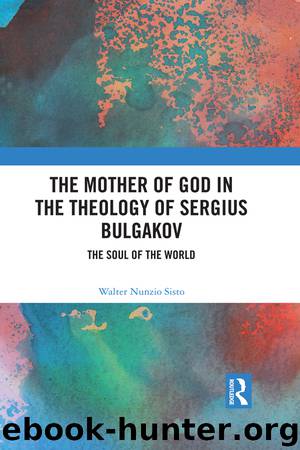The Mother of God in the Theology of Sergius Bulgakov by Walter Nunzio Sisto

Author:Walter Nunzio Sisto
Language: eng
Format: epub
Publisher: Routledge
The Burning Bush and virginity
The icon of The Burning Bush is based on a mariological interpretation of Moses’s Theophany, where the power of God consumes without burning the bush on Mount Sinai (Ex 3).70 For Orthodox Christians, the Burning Bush prefigures Mary’s theophany,71 the Annunciation, when Mary was not only overshadowed by the Holy Spirit but through the Holy Spirit, the second person of the Trinity incarnated in her womb. Playing on the image of the Burning Bush and Mary, he writes: Mary’s creaturely nature “burning and not being burned up in the divine flame of the Holy and Life-giving Trinity.”72 Mary’s ability to be touched by the “divine flame” of the Holy Spirit is not simply the result of the grace of her ancestors and her temple experience but also her virginity. Bulgakov links the Marian title “Burning Bush” to her title the “Ever-Virgin.” Relating virginity to the ability of Mary to be overshadowed and burn without being consumed by divine life may seem inordinate as well as somewhat forced. However, Bulgakov deemed the two intimately related, and Mary’s virginal state bespeaks to her unique ability to become the Mother of God. Bulgakov states unabashedly, “though a female being, Virgin and Mother, the Ever-Virgin is not a woman in the sense of sex… [she is] free from sex, higher than sex, ever virginal.”73 Virginity regarding bodily integrity and purity is intimately related to holiness. This is not an original thought. Not only is it a tradition in Orthodoxy but Pavel Florensky also writes about virginity. According to Bulgakov, virginity carries spiritual (i.e., purity/sanctity of conscience) as well as corporeal (i.e., lack of sex) overtones. Thus for Bulgakov, Mary’s virginity allows Mary to become the Burning Bush of the New Testament.
Nevertheless, Bulgakov argues that there are two kinds of virginity: historical and spiritual virginity. This is not to suggest that they are not related, as both senses of virginity are intimately connected, and Mary’s perpetual virginity (her historical virginity before, during, and after the Incarnation) is a result of her spiritual virginity, which is evident in her lack of sexuality.
Historical virginity refers to the lack of sexual intercourse. This is the dogma of Mary’s perpetual virginity. It is an article of faith for all ancient Christian communities who trace their origin to Jesus Christ (e.g., the Orthodox Church, the Coptic Church, and the Catholic Church to name a few). However, Bulgakov pushed this idea further, arguing that Mary’s virginity was required for the Incarnation. Bulgakov picks up an idea in certain patristics (e.g., John Chrysostom)74 that Mary’s virginity was necessary and indicative of God’s original intention for conception, virginal conception. Bulgakov’s logic for stressing the virginal conception as a normal, fully human mode of conception is straightforward: if Christ is the perfect man and the new Adam, then his conception should not be exceptional but rather fully and perfectly human. The result is that the virginal conception of Christ reveals something about God’s original intention for sex and human sexuality.
Download
This site does not store any files on its server. We only index and link to content provided by other sites. Please contact the content providers to delete copyright contents if any and email us, we'll remove relevant links or contents immediately.
Resisting Happiness by Matthew Kelly(3200)
The Social Psychology of Inequality by Unknown(2771)
Designing Your Life by Bill Burnett(2605)
Day by Elie Wiesel(2599)
The Giving Tree by Shel Silverstein(2178)
Angels of God: The Bible, the Church and the Heavenly Hosts by Mike Aquilina(1871)
Human Design by Chetan Parkyn(1859)
The Supreme Gift by Paulo Coelho(1802)
Jesus of Nazareth by Joseph Ratzinger(1710)
Augustine: Conversions to Confessions by Robin Lane Fox(1688)
Hostage to the Devil by Malachi Martin(1676)
7 Secrets of Divine Mercy by Vinny Flynn(1623)
Dark Mysteries of the Vatican by H. Paul Jeffers(1607)
The Vatican Pimpernel by Brian Fleming(1589)
St. Thomas Aquinas by G. K. Chesterton(1558)
Saints & Angels by Doreen Virtue(1532)
The Ratline by Philippe Sands(1425)
My Daily Catholic Bible, NABRE by Thigpen Edited by Dr. Paul(1418)
Called to Life by Jacques Philippe(1410)
